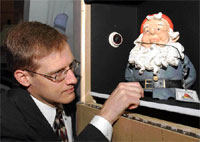Cameras look set to find their way onto airliners in an Orwellian fashion as, in the aftermath of 11 September airlines now look set to offer ‘big brother' style measures to keep passengers under closer surveillance.


George Orwell, in his book 1984, wrote that ‘Big Brother' would watch the populace through telescreens "in every possible place". Today, video cameras help law enforcement agencies observe everything from city streets and sports arenas to airports and the workplace. But few could have predicted the same cameras finding their way onto airliners.
All that changed with the 11 September terrorist attacks in the USA. Now, the prospect of passengers being monitored as they fly is a hot topic.
Even before 11 September, some airlines were considering equipping aircraft with video surveillance systems to alert crewmembers to air rage issues. Capturing such data on tape, it was argued, would give airlines hard evidence in the event of a lawsuit. But there were few buyers.
State-of-the-art
Today, protecting the cockpit from terrorist intrusion has put the issue back in the spotlight. A number of carriers, including Lufthansa, Virgin Atlantic and JetBlue Airways, have decided to deploy the video surveillance systems ahead of any government mandates. Other airlines, mainly US majors, are taking a wait-and-see approach, holding out until an FAA-sponsored pilot programme delivers some results.
The FAA hopes its test programme will provide "some real environmental testing data [on which] to eventually base a possible rule". It remains to be seen, however, who would pay for such systems.
Another question is whether video data should be recorded or transmitted to the ground for analysis and comparison against criminal databases. Technology is essentially in place to support these functions with major inroads having been made in combining biometrics – such as facial recognition or fingerprints – with state-of-the-art integrated camera systems. But privacy concerns, such as whether taped video should be used in court or to analyse union work rules, still exist.
The Association of Flight Attendants (AFA), for example, wants to ensure safeguards are in place before these functions are introduced. President Pat Friend says video surveillance systems "should record only the most recent 30 minutes and… should be protected security information". If used for an investigation, she says, the system should be "treated the same way as a cockpit voice recorder".
Many manufacturers are ready to supply airlines with video surveillance systems that support as many as 32 cameras in the cabin to feed images of the cockpit door, galley and cabin to computers in the cockpit. Goodrich, Rockwell Collins, Spirient, Securaplane Technologies, as well as Boeing's preferred suppliers Thales and JAMCO, are all in the game. Most of these manufacturers are demonstrating their cabin video surveillance systems at Farnborough.
So far, airlines seem most interested in using basic two-, three- and four-camera systems that would monitor the passenger cabin outside the cockpit door. However, manufacturers anticipate cabin-wide systems would eventually be deployed.
Goodrich, which has been chosen by Airbus to provide video surveillance platforms for all the manufacturer's production aircraft and by Lufthansa and Virgin Atlantic for fleet-wide retrofits, is initially offering a three-camera system that will monitor the cockpit door and forward galley. The system is readily expandable, however, to incorporate additional cameras and digital video recorders.
"Privacy is one of the reasons why we've talked about having an expandable system. A whole lot of issues must be worked out before wide-scale adoption," says Rich Feely, Goodrich Sensors marketing and sales director for commercial transport.
Rockwell has also seen increased interest for its cabin video surveillance systems. FAA pilot programme participant United Airlines is to launch a six-month test of the company's Video Intelligence System (VIS), which uses four pinhole cameras located at strategic but undisclosed locations in the passenger cabin to monitor cockpit door access.
Surveillance
The system transmits video feed from each camera via hard-wire and wireless networks to two flat-screen displays inside the flightdeck, so that each of the two on-duty pilots can view passenger cabin images from their seats on the flightdeck
Bob Geers, Rockwell Collins VIS business development manager, says that in the event airlines choose to record or transmit the data, they could alleviate privacy concerns by notifying passengers that video surveillance is in process.
Wayne Madsen, a senior fellow of the watchdog group Electronic Privacy Information Center (EPIC) in Washington, DC, warns that new observation and tracking technologies could "tear down many of the remaining veils on private activity". He admits, however, that people will likely sacrifice privacy rights in the name of safety and security
Source: Flight Daily News



















